Tel:+8618231198596

News
 CONTACT
CONTACT
 CONTACT
CONTACT
- Linkman:Linda Yao
- Tel: +8618231198596
- Email:linda.yao@dcpharma.cn
- Linkman:CHARLES.WANG
- Department:Overseas
- Tel: 0086 0311-85537378 0086 0311-85539701
News
Current Position:
Home >
News
>Nisin's Impact on Traditional Medicine: A Bridge Between East and West
Nisin's Impact on Traditional Medicine: A Bridge Between East and West
TIME:2023-12-21
1. Introduction:
Traditional medicine, characterized by centuries-old practices and holistic approaches to health, is experiencing a resurgence in interest globally. Nisin, a naturally occurring antimicrobial peptide, is emerging as a catalyst in this renaissance, offering a convergence between traditional healing philosophies of the East and the cutting-edge advancements of Western science. This article delves into the multifaceted impact of nisin on traditional medicine, exploring its potential therapeutic applications and the bridging of cultural health paradigms.
2. Nisin: A Natural Antimicrobial Powerhouse:
Nisin, derived from lactic acid bacteria, has been recognized for its potent antimicrobial properties. Used traditionally in food preservation, its application is expanding to the field of medicine. The unique mechanism of action, selectively targeting bacterial membranes, makes nisin a compelling candidate for therapeutic interventions, aligning with the holistic principles of traditional medicine.
3. Traditional Medicine in the East:
Eastern traditional medicine, encompassing systems such as Traditional Chinese Medicine (TCM) and Ayurveda, is rooted in a holistic understanding of the body, mind, and spirit. Herbal remedies, acupuncture, and dietary practices are integral components. Nisin's compatibility with these philosophies lies in its natural origin and potential to address microbial imbalances, aligning with the foundational principles of Eastern traditional medicine.
4. Nisin's Antimicrobial Role in Traditional Healing:
The antimicrobial prowess of nisin finds resonance in traditional healing practices that emphasize the importance of balancing the body's internal environment. Whether incorporated into topical ointments or administered internally, nisin holds promise in addressing infections, particularly those with bacterial origins, offering a complementary approach to traditional therapies.
5. Western Medicine's Integration of Nisin:
In the West, the utilization of nisin extends beyond its traditional applications. Western medicine, with its emphasis on evidence-based practices, is exploring nisin as a potential therapeutic agent against antibiotic-resistant bacteria. As research progresses, nisin's role in combating infectious diseases may become a cornerstone in Western medical approaches, creating a bridge between traditional and modern healing paradigms.
6. Nisin in Immune Modulation:
Traditional medicine, both Eastern and Western, acknowledges the significance of a balanced immune system in maintaining health. Nisin's potential to modulate the immune response opens new avenues for its integration into traditional healing practices. From immune-boosting tonics to formulations supporting immune resilience, nisin's immunomodulatory properties align with the holistic principles of traditional medicine.
7. Challenges and Considerations:
While the integration of nisin into traditional medicine holds immense promise, challenges such as dosage standardization, regulatory considerations, and cultural acceptance need careful attention. Collaborative efforts between traditional practitioners, scientists, and regulatory bodies can address these challenges and pave the way for responsible integration.
8. Synergies and Opportunities:
The intersection of nisin and traditional medicine creates synergies that go beyond antimicrobial applications. Collaborative research initiatives exploring the potential synergistic effects of nisin with herbal remedies, acupuncture, or other traditional therapies may unlock new dimensions in healthcare, offering comprehensive and culturally inclusive approaches to well-being.
9. Cultural Perspectives on Nisin's Integration:
Understanding cultural perspectives is vital for the successful integration of nisin into traditional medicine. Respect for cultural nuances, collaborative dialogue, and shared knowledge can foster a harmonious relationship between the ancient wisdom of traditional healing practices and the advancements in scientific understanding facilitated by nisin.
10. Future Directions and Global Health Implications:
The exploration of nisin's impact on traditional medicine opens doors to future research and applications. Global health implications, including the potential for collaborative initiatives addressing infectious diseases on a broader scale, underscore the importance of continued exploration and integration of nisin into diverse healthcare systems.
11. Conclusion:
As nisin transcends its traditional role in food preservation to become a key player in therapeutic applications, its impact on traditional medicine becomes increasingly apparent. This bridge between East and West holds promise for a more holistic, culturally inclusive approach to health and wellness. Nisin's journey from the fermentation vats of traditional food production to the forefront of integrative medicine epitomizes the potential for synergy between ancient wisdom and modern science, fostering a new era of healing possibilities.
- Tel:+8618231198596
- Whatsapp:18231198596
- Chat With Skype







